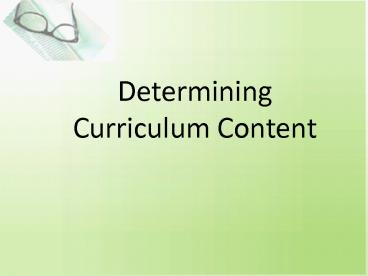Determining Curriculum Content - PowerPoint PPT Presentation
1 / 23
Title:
Determining Curriculum Content
Description:
Introspection. most expensive ... Introspection. examination (often including interviews) of existing literature and programs ... a variant of introspection ... – PowerPoint PPT presentation
Number of Views:733
Avg rating:3.0/5.0
Title: Determining Curriculum Content
1
DeterminingCurriculum Content
2
What Must Be Dealt With
- Time and money
- Emotional concerns
- Pressure from different groups
3
What Must Be Dealt With
- Content requirements- ex. completer courses in a
career pathway - Skills needed by employers-ex. future careers
will require more specific and employment skills - Content concerns-ex. integration
4
Types of Content Determination Strategies
Subjective
- Philosophical Basis
- Introspection
- DACUM
- Task Analysis
- Critical Incident Technique
- The Delphi Technique
Objective
5
Philosophical Basis
- most subjective but the most commonly used in
academic areas - belief or mission statements of the organization
should be reflected in the course- ex.
preparation for gainful employment all content
should relate to the workplace
6
Introspection
- most expensive
- carried out by an advisory committee made up of
members in touch with the related occupation - used to create a framework or blueprint
7
Introspection
- examination (often including interviews) of
existing literature and programs - a group process where members are asked What
do I feel should constitute the content of the
curriculum? - often requires further decision making processes
8
DACUM
- a variant of introspection
- single sheet skill profile- that presents the
skills of the entire occupation - see sample on p.145 in text
9
DACUM
- An expert committee made up of 10-12 people is
guided through the 2-4 day process by a
facilitator - Committee members are often nominated by
employers as being experts in their skill - Instructors/teachers are not involved in this
first step of the process they come in later to
take skill statements and organize them in a
framework
10
Task Analysis
- Task of workers (work activity units)
- are identified and verified.
- Consists of surveying workers and collapsing
data. - Steps
- review relevant literature
- develop an occupational inventory
- select a worker sample
- administer the inventory
- analyze the collected information
11
Task Analysis
- V-TECS- a cooperative effort between state
agencies to create catalogs of performance
objectives
12
The All Aspects Approach
- Based on the concept that we must train students
for broader workplace context - Exposes students to a broad predominant theme
- Content should be linked to the school, workplace
and community
13
The All Aspects Approach
- Themes might include technology, planning,
management, finance, safety, and environmental
issues. - Model- p.39 Figure 2-8
- Decisions based on consideration of contextual,
organizational and delivery options ex.
Biotechnology for Plants, Animals and the
Environment
14
Critical Incident Technique
- Limited use but can be used to isolate important
values and attitudes (affective education) - Involves employer reaction to poor performance of
employees - Data is gathered and grouped in categories- ex.
An employee is late to work three times in a week
would be put in the category of punctuality
15
The Delphi Techniques
- Useful in creating curriculum based on new
occupations/ no other data is available - Consist of a series of mailed questionnaires/inter
rogations - The group is not biased because they never meet
face to face - Time consuming
16
The Delphi Techniques
- Four rounds
- Request participate to send in a list of skills
or objectives - Each participate receives a total list and asked
to rank them all - Participates are asked to revise their first
choices based on others opinions - Review consensus rating and make final revisions
17
Analysis of Content Strategies
- Review all processes in Figure 6-6 p.161 of the
text - Which process allows the quickest collection of
data?
18
Making Curriculum Content Decisions
19
Consider Constraints
- Student Entering Characteristics
- General and applied skills
- Interest and motivation
- Maturity levels
- Special needs
- Other
20
Other Constraints
- Instructors and Support Staff
- Content instructors can teach
- Provision for teaching supporting coursework
- Provision for integrating general and vocational
education content - Availability of support staff (e.g., guidance,
placement)
21
Other Constraints
- The Curricular Arrangement
- Time available to teach students
- Required vocational content coverage
- Required general content coverage
- Funding available for equipment, resources, and
supplies - Other
22
Other Constraints
- The Employment Setting
- Minimum expected employability level of graduates
- Employment areas graduates will be prepared to
enter - Teaming experiences best obtained in employment
settings - Other
23
The Curriculum Framework
- In N.C. we call this the blueprint.
- A document that serves as a means of
communication to all those involved. - Needs to provide detail.
- Pulls it all together.































